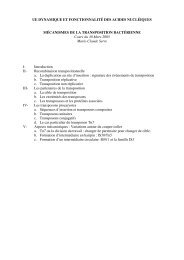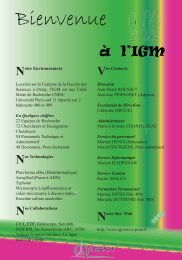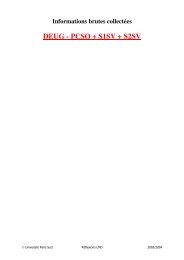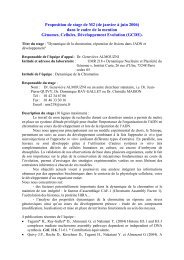Microbiology
Microbiology - Institut de Génétique et Microbiologie
Microbiology - Institut de Génétique et Microbiologie
- No tags were found...
Create successful ePaper yourself
Turn your PDF publications into a flip-book with our unique Google optimized e-Paper software.
Autumn Meeting 6–9 September 2010<br />
University of Nottingham – www.sgmnottingham2010.org.uk<br />
SESSION ABSTRACTS<br />
↑CONTENTS<br />
NT01 CONT.<br />
Nickel, iron and urease: the acid-resistance triangle of pathogenic Helicobacter species<br />
ARNOUD H.M. VAN VLIET 1 & Jeroen Stoof 2<br />
1<br />
Institute of Food Research, Norwich; 2 University of Nottingham, Nottingham<br />
The acidic gastric environment of mammals can be chronically colonized by pathogenic Helicobacter species (with Helicobacter pylori<br />
as the best known example). Nickel plays a key role in gastric colonization by Helicobacter species, as nickel cofactors the urease and<br />
hydrogenase enzymes. Both enzymes are essential colonization factors, with urease conferring acid resistance by urea hydrolysis, and<br />
hydrogenase allowing usage of microflora-produced hydrogen for energy production. Iron is also an essential metal for Helicobacter<br />
species, both for metabolism and for systems protecting against oxidative damage. Hence it is no surprise that Helicobacter species have<br />
intricate systems to both acquire sufficient nickel and iron to allow growth, while simultaneously preventing toxicity by uncontrolled<br />
nickel- and iron-acquisition. One interesting aspect is that nickel availability in the GI-tract is low, being mostly restricted to vegetarian<br />
dietary sources, and while this is no problem for Helicobacter species colonizing omnivores, it does present a challenge for Helicobacter<br />
species colonizing obligate carnivores. We have recently shown that these carnivore-colonizing Helicobacter species have adapted by<br />
expressing a second urease enzyme lacking nickel, demonstrating the intricate link between host, diet and pathogen evolution. In this<br />
overview the recent developments in Helicobacter urease, nickel- and iron-metabolism will be discussed.<br />
Interplay between manganese and iron during pneumococcal pathogenesis<br />
ALASTAIR G. MCEWAN 1 , Cheryl-Lyn Ong 1 Christopher A. McDevitt 2 , Adam J. Potter 2 , Abiodun D. Ogunniyi 2 &<br />
James C. Paton 2<br />
1<br />
School of Chemistry & Molecular Biosciences, The University of Queensland, St Lucia 4072, Australia; 2 Research Centre for<br />
Infectious Diseases; School of Molecular & Biomedical Science, University of Adelaide SA 5005, Australia (Email mcewan@uqedu.au;<br />
Tel. +61 7 3365 4622)<br />
Variation in transition metal ion concentrations may strongly influence pneumococcal virulence. The nasopharynx has a high level of<br />
available manganese, relative to iron, while in blood the opposite is the case. The response regulator RitR appears to be central to the<br />
response to iron in S. pneumoniae. A ritR mutant was defective in growth in medium with a high Fe/Mn ratio but was not affected when<br />
the ratio of Mn/Fe was increased. In a mouse model system the ritR mutant was able to colonize the nasopharynx but was unable to<br />
survive in lung or blood. Our results show that RitR is essential for the adaptation of pneumococcus to a high Fe/low Mn environment<br />
found in the lung and blood.<br />
Antimicrobial metals – back to the future?<br />
Jon L. Hobman<br />
School of Biosciences, The University of Nottingham, Sutton Bonington Campus, Sutton Bonington, Leicestershire LE12 5RD<br />
(Email jon.hobman@nottingham.ac.uk)<br />
Metals such as mercury, arsenic, copper and silver have been used in various forms as antimicrobials for certainly hundreds – if not<br />
thousands – of years. The discovery of antibiotics and new organic antimicrobial compounds during the twentieth century saw a general<br />
decline in the clinical use of antimicrobial metal compounds, possibly with the exception of silver for burns treatments. These ‘new’<br />
antibiotics and antimicrobials were regarded as generally being safer to the patient and more effective antimicrobials than the metalbased<br />
compounds they supplanted. However, increasing concerns about antibiotic and multidrug resistance (MDR) in emerging and<br />
re-emerging pathogens, and new, and rediscovered uses for antimicrobial metals have promoted a recent upsurge in interest in their use<br />
in both clinical and non-clinical products. Metal ion resistance mechanisms have already been characterized in a wide range of bacteria,<br />
but how widespread are these resistances in emerging and re-emerging pathogens? This talk will examine the evidence for antimicrobial<br />
metal ion resistances in recent genome sequence data from emerging pathogens – suggesting that the resistance genes are already<br />
present in some of these organisms – and will address some of the possible consequences of resistance to antimicrobial metals in these<br />
bacteria.<br />
Structure and function of Fur proteins from Mycobacterium tuberculosis<br />
Ehmke Pohl<br />
School of Biological & Biomedical Sciences, University of Durham, Durham University, South Road DH1 3LE<br />
The ferric uptake regulator (Fur) proteins form a diverse family of metal-dependent transcriptional regulator. Fur was originally identified<br />
in E. coli but homologues have been found in many Gram-positive and negative bacteria. Members of the Fur family control a wide<br />
Please note: Abstracts are published as received from the authors and are not subject to editing.<br />
society for general microbiology<br />
6 sgmconferences








